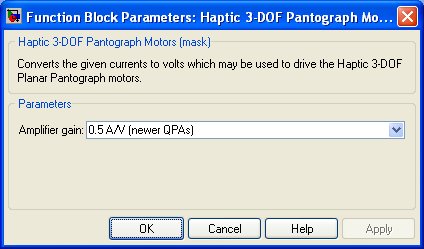

Haptic 3-DOF Pantograph Motors
Converts motor currents to D/A voltages that may be used to drive the motors of the Quanser Haptic 3-DOF Pantograph.
Library
QUARC Targets/Devices/Quanser/Haptics/Pantographs/Haptic 3-DOF Planar Pantograph/Interfacing MATLAB Command Line Click to copy the following command line to the clipboard. Then paste it in the MATLAB Command Window: qc_open_library('quarc_library/Devices/Quanser/Haptics/Pantographs/Haptic 3-DOF Planar Pantograph/Interfacing')
Description

The Haptic 3-DOF Pantograph Motors block converts motor currents in amperes to D/A voltages that may be used to drive the motors of the Quanser Haptic 3-DOF Pantograph. Use one of the HIL blocks to write to the analog outputs connected to the amplifiers of the Quanser Haptic 3-DOF Pantograph. The motor currents should be input as a 4-vector in the following order of the joints: front-top-left, front-top-right, back-bottom-left and back-bottom-right. The motor currents are dynamically saturated so that peak currents are allowed for a brief time to get rigid haptic effects, but the currents are then reduced to prevent damage to the device.
For the Quanser Q4 or Q8 card, analog output channels 3, 2, 1 and 0, in that order,
are typically used to write to the four joint motors of the Quanser Haptic 3-DOF
Pantograph, with channels 3, 2 1, and 0 corresponding to the joints in the required
order of front-top-left, front-top-right, back-bottom-left and back-bottom-right
respectively. For example, enter [3 2 1 0] as the analog channels in
a HIL Write Analog
block.
Input Ports
amps
The currents to drive the motors of the four joints in amperes. The currents must be input as a 4-vector in order of the joints, i.e., front-top-left, front-top-right, back-bottom-left and back-bottom-right.
Output Ports
volts
The voltages required at the analog outputs to produce the desired motor currents for the four joints. The voltages are output as a 4-vector in order of the joints, i.e., front-top-left, front-top-right, back-bottom-left and back-bottom-right.
Data Type Support
This block supports inputs and outputs of type double.
Parameters and Dialog Box

Amplifier gain
The gain of the QPA amplifiers driving the Haptic 3-DOF Pantograph. The gain of these amplifiers has changed in the latest version of the QPA. Newer QPAs will have a sticker indicating the new gain. Look for this sticker to determine whether you have a new QPA amplifier or not. Amplifiers sold in 2008 or later are likely configured for the new gain of 0.5 A/V. If you are not sure, it is safer to start with the old amplifier gain of 2 A/V because that will produce a lower current if the QPA is actually new.
Targets
|
Target Name |
Compatible* |
Model Referencing |
Comments |
|---|---|---|---|
|
Yes |
Yes |
||
|
Yes |
Yes |
||
|
Yes |
Yes |
||
|
Yes |
Yes |
||
|
Yes |
Yes |
||
|
Yes |
Yes |
||
|
Yes |
Yes |
||
|
Yes |
Yes |
||
|
Yes |
Yes |
||
|
Yes |
Yes |
||
|
Yes |
Yes |
||
|
Yes |
Yes |
||
|
Yes |
Yes |
||
|
Yes |
Yes |
Last fully supported in QUARC 2018. |
|
|
Rapid Simulation (RSIM) Target |
Yes |
Yes |
|
|
S-Function Target |
No |
N/A |
Old technology. Use model referencing instead. |
|
Normal simulation |
Yes |
Yes |
See Also

Copyright ©2025 Quanser Inc. This page was generated 2025-11-01. Submit feedback to Quanser about this page.
Link to this page.